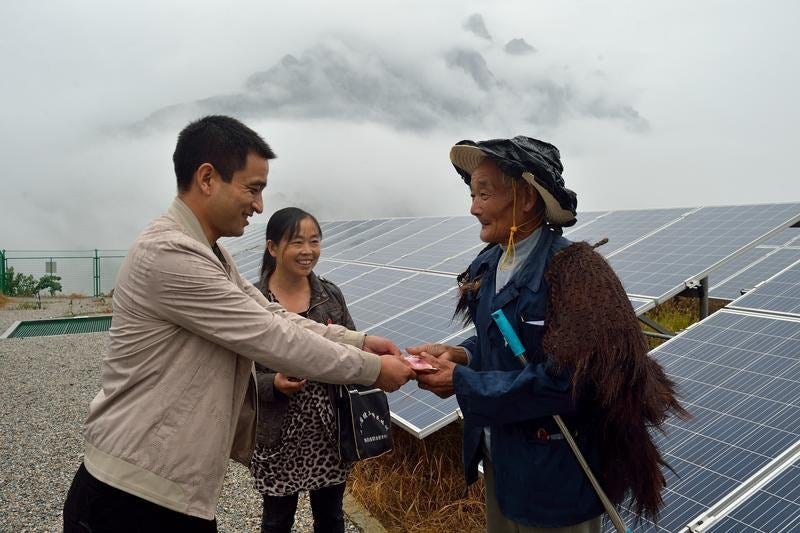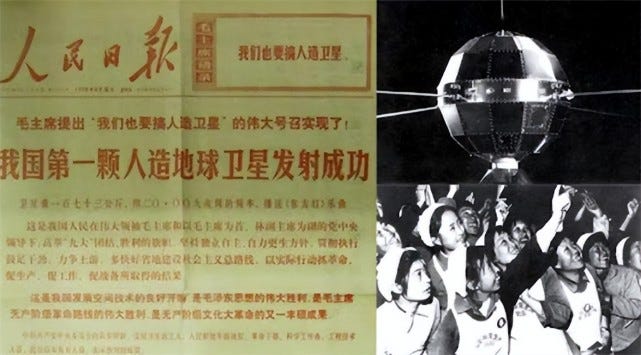ELECTROCHINA — First rays. I°: Chinese photovoltaics
First rays: from the dawn of an industry to its success
Photovoltaics in China: The Story of a Great Technological Success
Some thinking about Energy
The history of humanity and politics is closely linked to energy and the ways in which it is applied to various activities or stored to be used when needed. Every type of activity, whether human or animal, is based on energy; movements, hunting, reproduction, star observation, future planning, human creativity, and so on, ranging from the most basic needs of human beings to the noblest or non-strictly necessary irrational activities linked to survival.
Throughout the course of history, human, based on his needs and thanks to his intellectual abilities, has developed various ways of creating, transporting, and ultimately using energy. As Professor Nicolazzi recounts in his book 'In Praise of Oil,' the greatest energy source for nomadic tribes of humans was mammoths (or, in any case, large mammals from the Pleistocene)
Yes, exactly! Mammoths, with their enormous size and the ease with which they were hunted by humans, were the first source of protein suitable for the development and increase of human settlements. Towards the end of the Pleistocene, these large mammals began to dwindle, leading human communities to wonder how they could transition to different forms of sustenance or energy production. Man needed a new energy strategy. Some believe that this gave rise to the first forms of agriculture! This historical parable has repeated itself an infinite number of times throughout human history, with numerous transitions from one energy source to another. The various transitions that humanity has undergone have ranged from the most rudimentary forms of energy production based on natural forces, rooted in the sun, to fossil sources such as coal, oil, etc. Only recently have systems based on natural and renewable sources been returning to the forefront. This latest transition is happening thanks to unprecedented technological development, enabling a more efficient use of natural energy sources such as wind, sun, river basins, and geothermal, etc. The logic driving energy remains the same, primarily linked to raw materials, their extraction and processing, until their final application through a technological or biological means that transforms the potential energy of matter into motion or work.
Why renewables?
The sources of fossil energy have had and continue to have a central role in the globalized world. Transportation, industrial and agricultural production, electric lighting, etc., are all economic sectors closely intertwined with fossil fuels. In other words, it can be safely asserted that modernity, with its rhythms, fundamentally relies on fossil fuels. Our lifestyle, the current capitalist and consumer culture, deeply depend on the price of barrels of oil filled every day, or the dusty mountains of coal extracted from underground. This dependence on fossil fuels for the economic sustenance of a particular population is the 'substance' around which the current political and social substrate has developed, as well as the balance of power between different nations. At the core of every activity, as mentioned earlier, lies energy, and without energy, there is no way to compete. Therefore, when resources are limited and in the hands of a specific political actor, others in their absence could slowly lose the ability to choose their own future. In other words, oil, coal, and natural gas, as current primary energy sources, are essential elements for the independence and future of a nation.
Reasons that drive China to invest in renewables
China is well aware of its energy limitations, understanding that coal, despite being abundantly available in the sandy valleys of Shanxi and the vast plains of Inner Mongolia and Xinjiang, cannot be considered the ultimate solution for strong independence from the international energy context. In general, three key concepts can be identified as the foundation of Chinese energy choices: Sustainability, Independence, and Innovation.
Sustainability
In the documentary 'Under the Dome' directed by Chai Jing in 2015, the disastrous effects of pollution from fossil sources in China are highlighted. The concentration of fine particles in the air in Beijing has caused various health problems for the population, leading to severe economic and social disadvantages (companies relocating, delayed flights, outdoor activities banned, etc.). The problem is clear to the Chinese leadership; while this type of development has brought widespread economic prosperity to the population, it has also created long-term problems that can be harmful to economic development itself, creating a short circuit in national progress. This is one of the reasons why the sustainability, both socially and economically, of development through renewable energy sources is extremely important for the Communist leadershipIndependence
Independence is a key term when discussing energy, and the term itself carries a political connotation. The political sustainability behind photovoltaics, for example, lies in the ability to generate electrical energy and thus fuel progress without relying on countries with different economic interests. For China, not only is this possible, but it is also more desirable than in other countries, as approximately 60% of the energy is still produced through coal-fired power plants. In the 15th five-year plan presented in March 2021 by the Chinese Communist Party (CCP), the definition of Chinese intentions in the environmental field stands out: 'Promote green development and facilitate the harmonious coexistence of humans and nature' (推动绿色发展 促进人与自然和谐共生). At the organizational and political levels, China has a tremendous advantage in terms of state planning (five-year plans). This system, combined with a modern market economy, aims to guide and capitalize on the efforts of the entire country for a transition primarily strategic for China's energy independence and, perhaps, the dependence on it for other international actors.
Innovation
If today there are advancements in the technological efficiency of renewable energies, it is primarily due to Chinese companies and the system that has evolved behind the incentives of the Chinese government in electrifying rural areas. Since the early 2000s, the Chinese government initiated an extensive campaign to connect rural areas to the national grid under the name 'Chinese Village Power Access' (村村通动力电). This massive project, launched under the auspices of the Chinese Communist Party, aimed to modernize a large segment of the Chinese rural population, which in the early 2000s accounted for over half of the national population.
After years of efforts and investments by the government, a high level of electricity supply was achieved even in more remote areas such as Xinjiang, Gansu, and Tibet. Thanks to this access, the renewable energy sector has a broad market to develop a variety of products and solutions. Moreover, this extensive demand has supported the local production of solar technology even during periods when the Chinese market, for various reasons as I will explain later, was isolated from international trade.
The development stages of solar energy in China
1997-2004: The Origins of Solar in China
2005-2008: China Encircled
2008-2012: Chinese Solar Counterattacks
2012-2013: Return to the Inner Regions; The Chinese Response
2013-2017: In Search of a New Path
2018-Present: Market Control and Internal Competition
1997-2004: The Origins of Solar in China
After years of research and development conducted by Chinese scholars, photovoltaic technology is put into use on the first satellite, the famous DongFang Number 1, or East is Red (东方红一号), on April 24, 1970. In 1984, the first photovoltaic power plant in China was donated and installed by the Japanese company Kyocera in a rural area of Gansu. The project, originally designed to produce 10 kW, still generates energy for 6 kW today, after 40 years!
At the beginning of the 2000s, the Chinese government began to protect and develop the domestic photovoltaic industry. Two long-term projects were primarily initiated:
1997: The "Sunshine" Project (光明工程): This project aimed to bring clean energy through the installation of wind and solar power plants to more than 700 villages located in the internal regions of China (Tibet, Xinjiang, Gansu, Qinghai, Inner Mongolia, Shanxi, and Sichuan), where the energy grid load is often extremely unstable or nonexistent. The government's intention was to develop an internal industry to meet the needs of China's internal regions.
2002: Bringing Energy to Villages (送电到乡): This project, like many other far-reaching and long-term initiatives, falls under the broader umbrella of strategies and reform plans that have transformed China since the late 1970s, initiated by Deng Xiaoping. The project mainly focused on basic infrastructure, seeking to expand and enhance the energy grid in the internal regions.
The first major Chinese companies were established to serve the more remote regions of the country, driven by the central government's planning and resource distribution. Among these, there are giants that still dominate the market, such as LONGi, and others that have had less success, like Suntech. With China's entry into the WTO and the new plan for renewable energy introduced by the German government in 2003 (EEG), Chinese companies had their first opportunity to go beyond national borders. Due to lower labor costs compared to European companies, they managed to gain a competitive foothold in the market.
These were years of growth but precarious growth due to the fragility of resources in the Chinese market and, of course, because China, excluding the internal regions where the state is directly investing, did not have any policies in favor of the solar energy price (unlike Germany). Local rapidly growing companies had no choice but to look outward and depend on the international market to sustain internal growth. This marked the emergence of the "Three Outside" problem (三头在外). The three vital factors needed for the development of the Chinese photovoltaic industry but found outside its borders are: 1) Raw materials (primarily silicon) 2) Industrial machinery 3) Technology. China, on its side, had only two competitive factors: 1) Low labor costs 2) A stable and long-term political environment.
With low-cost production, despite heavy dependence on the European market, Chinese companies began to accumulate capital and increasingly significant productions, going from about 0.78% of the global market share in terms of assembled modules in the early 2000s to around 1088 MW of production around the year 2008. In those years, China became the largest producer (or perhaps we could define it as an "assembler") of photovoltaic modules in the world, covering up to 70% of the global production.
2005-2008: China Encircled
With the financial crisis of 2008, the Western world entered a profound investment crisis. Governments struggled to uphold the promises made for renewables at the beginning of the 2000s. Angela Merkel's Germany withdrew heavy investments supporting photovoltaics. Similarly, Spain withdrew part of the funds dedicated to power plants below 500 MW. Chinese companies entered a loop of overproduction, driving down the production cost of solar panels well below the European market average. In other words, they were producing at a loss and in extreme dependence on the European and U.S. markets, which, in turn, were in economic crisis
2008-2012: Chinese Solar Counterattacks
For some, the Western economic and financial crisis was an almost definitive death sentence for the Chinese solar sector, which was just in its infancy and lacked the necessary resources and resilience. However, Chinese companies continued to produce and sell their solar modules, effectively annihilating competition in export markets (Germany, the United States) over the years but with increasingly meager revenues. Revenues were declining, if not in certain cases incurring losses, but products continued to flow from China to both the new and old continents.
This type of competition, based on low-cost production and effectively financed in China by banks and the government through excellent fiscal instruments (low-interest loans, etc.), prompted the U.S. government and the EU Commission to open an investigation into the production of Chinese photovoltaic modules. Europeans and Americans, generally the Western world, sought to demonstrate that Chinese companies were using "dumping" techniques to flood foreign markets, considered not only harmful to the market itself as they annihilated competition with prices impossible to rival but also against the laws of the international market protected by the World Trade Organization (WTO). The result of the investigation produced by the U.S. Department of Commerce in 2011 led to additional tariffs on all types of solar panels produced in China and Taiwan. These unidirectional tariffs aimed at the Asian giant were later called 'Discriminatory Tariffs' as they were specifically designed to target Chinese production. These tariffs served as a warning bell for what would later become the trade war between the United States and China starting in 2018. China, of course, responded with additional tariffs on some American products, but the real response was its internal aid program for the industry, called the 'Golden Sun' project. In 2009, the Ministry of Finance and the Ministry of Science and Technology relaunched solar energy in the Chinese domestic market. The Golden Sun project envisaged a 70% coverage of the installation costs for photovoltaic parks. For installations exceeding 300 kW, national refunds of up to 50% were provided, with a cap of 20 MW per province. Thanks to the Golden Sun project, China aimed to support the domestic manufacturing industry while simultaneously expanding electricity coverage in the needy internal regions.
2012-2013: Return to the Inner Regions; The Chinese Response
In the 12th Five-Year Plan, issued by the Chinese Communist Party in 2011 (第十二个五年规划 2011-2015), government strategies in support of solar energy were made public. Among these, national programs supporting the private solar market for commercial enterprises and individuals were disclosed, encompassing a series of initiatives such as:
10.2012: "Opinions on the Distributed Generation of Photovoltaic Energy and Network Services" (关于做好分布式光伏发电并网服务工作的意见). This document is presented as a scientific and rational approach to working on the private photovoltaic market. With this document, private investors gain greater security and transparency regarding the installation of solar modules and the buying and selling of renewable electricity.
7.2013: "Several Opinions on the Healthy Advancement of the Photovoltaic Industry" (国务院关于促进光伏产业健康发展的若干意见). This document provides guidance to the private market on how to develop and intensify capital investments in the domestic market, with a focus on the western regions of China. In the document, the government establishes rules and sets long-term objectives, aiming for a 66% growth in installations in the domestic market within two years.
8.2013: "Notice on the Role of 'Price Cap' in Promoting the Healthy Development of the Photovoltaic Industry" (国家发展改革委关于发挥价格杠杆作用促进光伏产业健康发展的通知). This announcement marks the beginning of the era of state subsidies for energy prices. Similar to what happened in Germany in the early 2000s, the Chinese government begins to effectively subsidize the price of solar energy, making the production and installation of modules economically viable. Subsidies reach up to 0.42 Yuan per kWh for distributed solar energy (private customers) and, depending on the provinces, up to 0.98 Yuan per kWh for large-scale installations (mainly state or corporate entities).
2013-2017: In Search of a New Path
In 2014, in response to the discriminatory tariffs imposed by the United States, China establishes new taxes on polysilicon produced on American soil. This move has a dual purpose for the solar industry in China. On one hand, it impacts the U.S. economy, forcing the U.S. Congress to reconsider the dangerous game of escalating trade tensions through customs duties (resulting in job losses in both China and the United States). On the other hand, it aims to build a more extensive production chain than it already had, leading to the development of certain industrial segments on which China was still dependent. Before 2014, the majority of processed polysilicon (in ingots) was imported from the United States to China. However, by 2019, China was producing three-quarters of the world's polysilicon.
In 2015, the National Development and Reform Commission of China (NDRC, 国家发改委) released a document highlighting technological ambitions for the development of solar energy in China. The mission from 2015 onward for the NDRC is to select and subsidize strategic champions in the Chinese solar sector, leading to the program being called "Forerunner." From 2013 to 2017, these are years of technological development and an unprecedented climb to the top in the Chinese domestic market. Chinese manufacturers now have no global competitors. The price of photovoltaic energy in China, during auctions for projects, is approaching that produced by non-renewable sources, even without government subsidies.
2018-Present: Market Control and Internal Competition
In 2012, the famous German company Q-Cells, once a leader in the production of photovoltaic modules, filed for bankruptcy, along with many other companies in the German "Solar Valley." Following the restructuring that took place in China for the supply chain related to polysilicon, the situation tilted in favor of the Asian giant. The scale of production achieved in China is unprecedented, and as of 2021, China held over 75% of the global supply chain necessary for the complete design, production, and installation of photovoltaic panels.
Today, the overall scenario is dominated by several factors:
The constantly decreasing price of solar energy, now close to the price of energy from fossil sources.
Intense internal competition in the Chinese market, pushing companies to seek necessary outlets abroad.
National and protective measures by the United States and the EU to combat inflation and create internal industrial economy, such as the Inflation Reduction Act (IRA) and the REPowerEU plan.
International commitment to reduce and achieve carbon neutrality by 2060, repeatedly emphasized in the annual Conferences of the Parties (COP).
Many have questioned whether it will be possible to maintain such a level of development and prosperity by relying solely on new forms of renewable energy. China will undoubtedly play a crucial role in the future of renewables and solar.
We will keep watching this.
我们拭目以待









